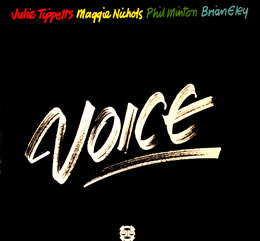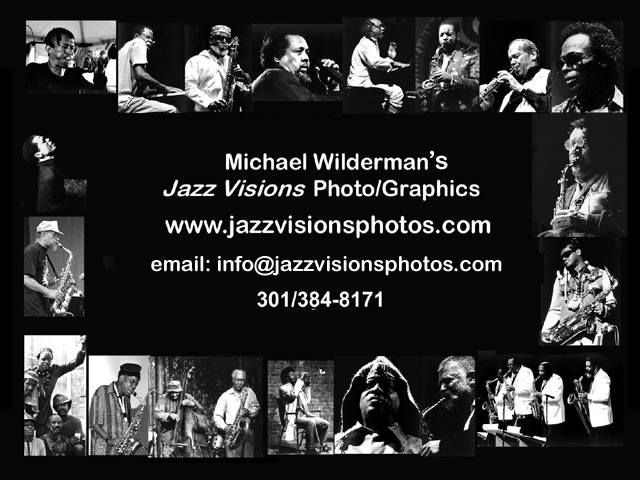The Circle with a Hole in the Middle
Rare Vinyl Revisited
by
Bill Shoemaker
Julie Tippetts + Maggie Nicols + Phil Minton + Brian Eley
Voice
Ogun OG 110 (1976)
 The history of improvised music in the UK is largely a history of extremely short-lived groups. In such an ephemeral environment, reputations can be sustained for years on the basis of a gig or two, and a recording establishes a legacy. The latter was particularly true in the 1970s, when the prohibitive expense of producing an LP severely winnowed what was documented. Voice enjoyed relative longevity; however, the quartet of vocalists Maggie Nicols, Julie Tippetts, Phil Minton and Brian Eley gave few concerts, one of which was produced by Anthony Wood, who later founded The Wire. An October 1976 gig at The Phoenix, a venue on Cavendish Square, was the occasion for their sole, eponymous album, which is brimming with electrifying singing.
The history of improvised music in the UK is largely a history of extremely short-lived groups. In such an ephemeral environment, reputations can be sustained for years on the basis of a gig or two, and a recording establishes a legacy. The latter was particularly true in the 1970s, when the prohibitive expense of producing an LP severely winnowed what was documented. Voice enjoyed relative longevity; however, the quartet of vocalists Maggie Nicols, Julie Tippetts, Phil Minton and Brian Eley gave few concerts, one of which was produced by Anthony Wood, who later founded The Wire. An October 1976 gig at The Phoenix, a venue on Cavendish Square, was the occasion for their sole, eponymous album, which is brimming with electrifying singing.
Voice brought Tippetts, Nicols and Minton together as they were taking their respective approaches to new levels. During the early ‘70s, Tippetts had moved progressively farther away from the song forms she employed on her classic album, Sunset Glow, working with ensembles like Spontaneous Music Ensemble and Ovary Lodge, and one-time collaborations like TTTP, with pianists Keith Tippett and Stan Tracey, and saxophonist Evan Parker. Minton was making a similar transition, embarking on his watershed solo performances; prior to ’75, he was best known for singing with Mike Westbrook’s bands, including the jazz-rock oriented Solid Gold Cadillac. Nicols’ work became increasingly melded with activism in the form of community-based improvisation workshops and in extending the idea of community through ensembles like Feminist Improvisation Group with woodwind play Lindsay Cooper, pianist Irene Schweizer and others.
The fourth member, Brian Eley, had attended Nicols’ workshops and performed with John Stevens’ Spontaneous Music Orchestra. Eley’s is the voice heard on “In Relationship To Silence,” a 1973 piece included on Mouthpiece (Emanem 4039); according to producer Martin Davidson, Eley is most likely on the other tracks as well. There is scant journalistic evidence of Eley’s presence on the London improvised scene during the 1970s, and it is largely entangled in conflicting chronologies set out in various chapters of John Wickes’ Innovations In British Jazz, Volume One 1960-1980 (Soundworld; 1999). Wickes’ one reference to Eley outside the context of Voice is his playing saxophone in keyboardist Julian Marshall’s little-known fusion group, Quincicasm, is incorrect. Eley’s membership in Voice led to his performing on Land Of Stone, a 1977 Japo LP by Ken Hyder’s Talisker. Hyder had tapped the entire group; but due to a schedule conflict, Tippetts was replaced by Frankie Armstrong. Already a graphic designer for BBC Television during his membership in Voice – he also designed the “classic” Resonance FM logo for the London Musicians Collective – Eley stopped performing by the end of the 1970s to pursue his career. He is now a partner at Dunning Eley Jones, an award-winning London-based design agency.
Tippetts and Nicols had already worked as a duo. Their work ventured beyond the commonly accepted parameters of vocalese, exploring what could be considered the frontier between improvised music and theater as means to engage an audience. Late in the ‘70s, the duo revisited this approach on their album, Sweet And S’ours. There are traces of these methods on Voice, but nothing that is provocative, let alone outrageous. On the contrary, there is an inviting, communal quality to the quartet’s singing even when the material is at its most abstract.
More often than not, the five performances have clearly delineated themes. Minton’s “Louis Kappa” is built upon two rhythmically charged motives that sound African one second and Gregorian the next. For most of the performance, Eley and Minton stay close to home while Tippetts and Nicols soar, plying thrilling long notes and jubilant embellishments upon one another. Nicols’ “Yilf Kofla” has three distinct parts: a prelude of long centering tones; a unison work song-like theme that suggests a step-by-step struggle; and a double time figure that is gleeful by comparison. Ending the A side with delicate skeins of glissandi and long tones, Nicols’ “Ego Worry” prompts fitting comparisons with composers like Ligeti.
There is such an easy flow from the aptly titled “African Breezes” to the sparse beginnings of Minton’s “Singing Wood” that, in lieu of a CD index, watching the stylus track is the only sure way to know when the first track of the B side ends, and the second, album-ending cut begins. The collectively derived “African Breezes” rises and falls; quiet murmurs and gentle calls coalesce around Nicols and Tippetts’ suddenly spiking high long tones or the group latching onto a riveting rhythmic figure. Still, for all of the latitude exercised on this and the A side tracks, Voice’s performances are rigorously compact compared with Minton’s nearly 16-minute “Singing Wood.” Were Voice to reconvene in the CD era, such durations would probably be closer to the norm than the five to eight minute performances that comprise most of the CD. As it is, this is the most forward-looking track of the lot, in that surreal sounds hold sway to a greater degree, and there is more space to develop theatrical facets, including a passage where the singers sound like a gaggle of cartoon creatures. Still, the piece also contains some of the most spiritually-inspired unisons of the set.
Nicols, Tippetts and Minton have occasionally worked together subsequent to Voice, most notably in Dedication Orchestra.
